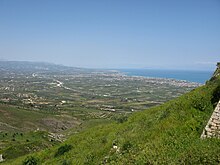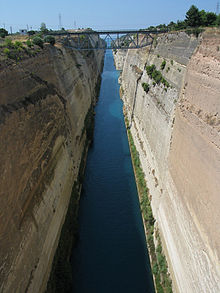Gulf of Corinth



The Gulf of Corinth or the Corinthian Gulf (Κορινθιακός Kόλπος, Korinthiakόs Kόlpos, in Greek) is a deep inlet of the Ionian Sea separating the Peloponnese from western mainland Greece. It is bounded in the east by the Isthmus of Corinth which includes the shipping route of the Corinth Canal, and in the west by the Strait of Rion, which separates the Gulf of Corinth from the outer Gulf of Patras at Cape Drepano, where the narrowest point is crossed by the Rio-Antirio bridge. The Gulf of Corinth is almost surrounded by the prefectures of Aetolia-Acarnania, Phocis in the north, Boeotia in the northeast, Attica in the east, Corinthia in the southeast and south and Achaea in the southwest. The gulf is one of the most seismically active regions in Europe.
In medieval times, the gulf was known as the Gulf of Lepanto. The third Battle of Lepanto was fought here in 1571, destroying the Ottoman fleet. In 1772 another Turkish fleet was destroyed by the Russians at the entrance to the gulf. The town of Lepanto is now named Naupactus.
The shipping routes between Athens and to the ports of the rest of the world including the Mediterranean ports pass along this gulf. Ferry routes link Aigio and Agios Nikolaos in the western part of the gulf.
- Length: 130 km (81 mi)
- Width: 8.4 to 32 km (5.2 to 19.9 mi)
- Max Depth 935 m (3,068 ft)
Geology
The Gulf was created by the expansion of a tectonic rift due to the westward movement of the Anatolian Plate, and expands by 10 mm (0.39 in) per year.[1] The surrounding faults can produce earthquakes up to magnitude 6.8, though they are relatively uncommon.
Gulfs and Bays
- Alkyonides Gulf, east
- Crisaean Gulf, north
- Dombraina (Domvrena), north
- Strait of Rio, west
Bridges
Cities and towns
The cities and towns that lie next to the gulf are:
- Nafpaktos (northwest)
- Sergoula Beach, no port, beach
- Glyfada, no port
- Spilia, no port
- Agios Nikolaos (north)
- Galaxidi (north), small port
- Itea (north), small port
- Kirra (north), no port
- Agios Vasileios, small port
- Porto Germeno (Aigosthena), east, small port, beaches
- Psatha, east, huge beach
- Alepochori, (southeast)
- Loutraki, no port
- Corinth (southeast)
- Kiato, (southeast)
- Xylokastro (south)
- Derveni
- Krathio (southwest), no port
- Diakopto (southwest), beach town
- Aigio (southwest)
- Patras (southeast), major port
- Longos (southwest)
- Selianitika (southwest)
- Akoli Beach (southwest)
- Kato Rodina (west southwest)
- Psathopyrgos (west)
Tributaries
Northern ebbing
- Mornos River
Southern ebbing
- Volinaios River
- Selemnos River
- Creek E of Arachovitika and Drepano
- Selinounta River
- Vouraikos River
- River east of Diakopto
- Stygas River
- Zacholitikos River
- Asopus River (Corinthia)
- Sythas River - Xylokastro
References
- ^ "Ambraseys, N.N. & Jackson, J.A. 1997. Seismicity and strain in the Gulf of Corinth (Greece) since 1694. Journal of earthquake engineering, 1, 433-474". Informaworld.com. 1970-01-01. Retrieved 2012-05-17.
